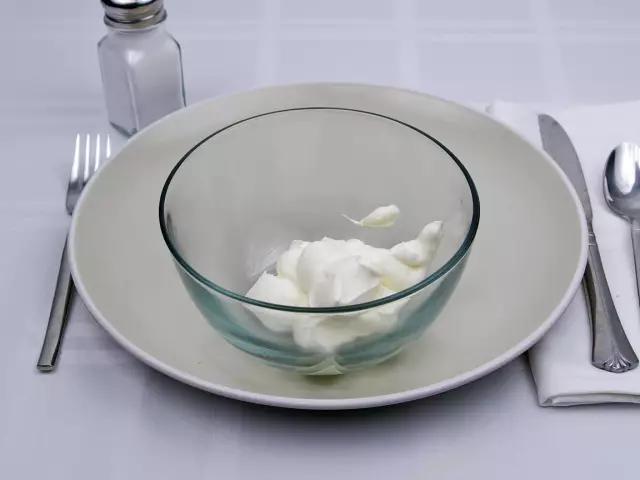- Author Rachel Wainwright [email protected].
- Public 2023-12-15 07:39.
- Last modified 2025-11-02 20:14.
Binafin
Binafin: instructions for use and reviews
- 1. Release form and composition
- 2. Pharmacological properties
- 3. Indications for use
- 4. Contraindications
- 5. Method of application and dosage
- 6. Side effects
- 7. Overdose
- 8. Special instructions
- 9. Application during pregnancy and lactation
- 10. Use in childhood
- 11. In case of impaired renal function
- 12. For violations of liver function
- 13. Use in the elderly
- 14. Drug interactions
- 15. Analogs
- 16. Terms and conditions of storage
- 17. Terms of dispensing from pharmacies
- 18. Reviews
- 19. Price in pharmacies
Latin name: Binafin
ATX code: D01AE15
Active ingredient: terbinafine (terbinafine)
Manufacturer: Shreya Life Science Pvt. Ltd. (Shreya Life Sciences Pvt. Ltd.) (India)
Description and photo update: 2019-23-08
Prices in pharmacies: from 110 rubles.
Buy

Binafine (international name Terbinafine) is a drug for the treatment of fungal infections.
Release form and composition
Binafina release forms:
- Tablets: round, biconvex, from white to white with a yellowish tinge of color (14 pcs. In blisters, 1 blister in a cardboard box);
- Cream 1%: soft, homogeneous, white (in tubes of 10, 15 and 30 g, 1 tube in a cardboard box).
The active substance is terbinafine hydrochloride:
- 1 tablet - 125 or 250 mg;
- 1 g of cream - 10 mg.
Excipients:
- Tablets: microcrystalline cellulose, starch, povidone, colloidal silicon dioxide, sodium lauryl sulfate, sodium methylparaben, magnesium stearate, talc, sodium starch glycolate;
- Cream: ketosteril alcohol, soft white paraffin, liquid paraffin, methylparaben, ketomacrogol, isopril myristate, sodium acid phosphate, propylparaben, water.
Pharmacological properties
Pharmacodynamics
The active component of Binafine - terbinafine - is a synthetic antimycotic agent of the allylamine class with a broad spectrum of antifungal action.
Terbinafine is active against pathological microflora that causes diseases of the skin, nails and hair: dermatophytes of the genus Trichophyton (T. rubrum, T. mentagrophytes, T. tonsurans, T. verrucosum, T. violaceum), Epidermophyton floccosum, Microsporum canis, as well as yeast-like fungi of the genus Candida (including Candida albicans) and Pityrosporum (Malassezia restricta and globosa).
In low doses, terbinafine exhibits fungicidal activity against molds, dermatophytes and some dimorphic fungi. On yeast-like fungi, depending on their type, the action can be fungistatic or fungicidal.
Due to the ability of terbinafine to specifically inhibit the biosynthesis of sterols in the fungal cell, at an early stage, ergosterol deficiency and intracellular accumulation of squalene occur, which causes the death of the fungal cell. The effect of terbinafine is based on its inhibition of the enzyme squalene epoxidase in the cell membrane of the fungus. Since the enzyme is not part of the cytochrome P 450 system, terbinafine does not affect the metabolism of hormones, as well as other medicinal substances.
Pharmacokinetics
- absorption: due to a single oral intake of 250 mg of terbinafine, its maximum concentration (C max) in plasma is reached after 2 hours and is 0.97 μg / ml; the half-absorption period is 0.8 h; food intake has no effect on the bioavailability of the substance. As a result of applying the cream, <5% of the dose is locally absorbed, and therefore the systemic effect of the drug is minimal;
- distribution: up to 99% of terbinafine binds to blood plasma proteins; its half-life is 4.6 hours; the substance quickly penetrates into the dermis and accumulates in the lipophilic stratum corneum, and also has the ability to penetrate the secretion of the sebaceous glands, due to which, in the first few weeks, high (fungicidal) concentrations of the substance are created in the nails, hair follicles and skin rich in sebaceous glands;
- metabolism: a rapid biotransformation of terbinafine occurs in the liver with the participation of cytochrome P 450 isoenzymes CYP2C9, CYP1A2, CYP3A4, CYP2C8, CYP2C19, as a result of which inactive metabolites are formed;
- excretion: terbinafine is excreted mainly by the kidneys as metabolites. Its half-life (T 1/2) is ~ 17 hours; there is no evidence of accumulation of the substance in the body; terbinafine is also excreted in breast milk.
No age dependence of the steady-state concentration (C ss) of terbinafine was found.
With impaired hepatic or renal function, the rate of excretion of terbinafine may be slowed down, which leads to higher plasma concentrations. In the course of pharmacokinetic studies, taking a single dose of Binafine in patients with concomitant liver dysfunction showed the possibility of reducing the clearance of terbinafine by 50%.
Indications for use
- Fungal infections of the skin (dermatomycosis);
- Mycoses of the scalp;
- Onychomycosis (fungal nail infections) caused by dermatophyte fungi;
- Yeast infections of the skin caused by fungi of the genus Candida;
- Versicolor versicolor (for cream).
Contraindications
Absolute:
- lactation period (breastfeeding);
- children up to 2 years old, child weight up to 12 kg - for tablets;
- children under 12 years old - for cream;
- hypersensitivity to any component of the drug.
Pregnancy is a relative contraindication for the use of Binafin. If necessary, the drug is used with caution, only as directed and under medical supervision.
Instructions for use of Binafin: method and dosage
Binafin tablets must be taken once a day.
A single dose is prescribed based on the patient's body weight:
- Children weighing less than 20 kg - 62.5 mg (1/2 tablet of 125 mg);
- Children weighing from 20 to 40 kg - 125 mg;
- Children weighing over 40 kg and adults - 250 mg.
Correction of the dose of Binafine in elderly patients is not required, provided that they do not have symptoms of hepatic and renal failure.
The duration of therapy depends on the severity of the disease:
- Skin infections - 2-6 weeks
- Fungal infections of the scalp - 4 weeks;
- Fungal lesions of the nail plates - from 6 to 12 weeks.
Binafin cream is prescribed for adults and children over 12 years old. The drug is applied to previously cleansed and dried affected skin areas with light massaging movements 1-2 times a day. If the cream is used at night, then the application site can be covered with a gauze bandage. The duration of treatment is 1-2 weeks.
Side effects
The use of Binafin can cause the following side effects:
- Lack of appetite, nausea, abdominal pain, diarrhea, impaired taste; in rare cases - liver failure;
- Arthralgia, myalgia;
- Agranulocytosis, neutropenia, thrombocytopenia;
- Allergic reactions: urticaria, rash, Stevens-Johnson syndrome, toxic epidermal necrolysis.
With progressive skin rash, drug treatment must be canceled.
Overdose
There have been reports of several episodes of Binafine overdose, when a dose of up to 5 g of terbinafine was taken orally, resulting in nausea, headache, dizziness, and epigastric pain.
For the treatment of overdose, gastric lavage is recommended, followed by the intake of absorbents (activated carbon), if necessary, supportive symptomatic treatment.
There is no data on an overdose of Binafin cream for external use. In case of accidental ingestion, one can expect the development of the same systemic adverse reactions as for tablets.
special instructions
If, during the treatment with Binafin, the patient develops persistent nausea, vomiting, lack of appetite, pain in the right hypochondrium, fatigue, dark urine, lightening of the stool, then it is necessary to pass a biochemical blood test for liver enzymes (ALT, AST) and cancel therapy with this drug. The patient should be aware of the need to see a doctor if such symptoms occur.
In patients with impaired renal function (serum creatinine concentration - more than 300 μmol / l), it is recommended to reduce the dose of the drug by 50%.
Influence on the ability to drive vehicles and complex mechanisms
There are no reports of the negative effect of Binafin on the ability to drive a car and work with complex mechanisms.
Application during pregnancy and lactation
During pregnancy, the use of Binafine is allowed, provided that the benefits of treatment for the mother outweigh the potential harm to the fetus.
Since terbinafine passes into breast milk, if it is necessary to use Binafine during lactation, breastfeeding should be discontinued.
Pediatric use
There is insufficient data on the safety and efficacy of taking Binafin tablets in children under 2 years of age and / or with a child's body weight less than 12 kg, therefore, the drug is not prescribed for this category of patients. Systemic use of terbinafine is well tolerated in children over 2 years of age with a body weight of more than 12 kg.
Binafin cream is not recommended for use in children under 12 years of age.
With impaired renal function
Patients with renal failure [with creatinine clearance (CC) up to 50 ml / min or serum creatinine concentration above 300 μmol / l], the dose of the drug must be halved.
For violations of liver function
According to the instructions, Binafin is not recommended for use in case of concomitant violations of liver function, since there is insufficient data from clinical studies to study the course of the drug in this contingent.
Use in the elderly
Elderly patients do not need a dose adjustment of Binafin, but when taking the pills, it is necessary to take into account the likelihood of concomitant liver and / or kidney dysfunction in patients of this age category.
Drug interactions
Possible drug interactions with systemic use of terbinafine:
- tolbutamide, cycloserine, triazolam, oral contraceptives, other drugs metabolized with the participation of the cytochrome P 450 system: terbinafine slightly reduces or increases their clearance;
- tricyclic antidepressants, β-adrenergic blockers, monoamine oxidase (MAO) inhibitors of type B, selective serotonin reuptake inhibitors (SSRIs), other drugs and substances metabolized by the cytochrome CYP2D6 isoenzyme: terbinafine, when administered simultaneously, can have a clinically significant effect on them due to the fact that inhibits the metabolism of this isoenzyme;
- oral contraceptives: in patients taking Binafine at the same time, there is a violation of the regularity of the menstrual cycle, which is within the values recorded when taking only oral contraceptives;
- rifampicin and other inducers of cytochrome P 450: may increase the total clearance of terbinafine, an adequate correction of the dosage regimen may be required;
- cimetidine and other inhibitors of cytochrome P 450: the total clearance of terbinafine may be slowed down, an adequate adjustment of the dosage regimen may be required.
Due to the low systemic absorption, there is no drug interaction of Binafin cream.
Analogs
Binafin's analogues are: Atifin, Exifin, Terbizil, Terbinox, Thermikon, Tigal-Sanovel, Lamisil, Lamisil Uno, etc.
Storage conditions and periods
- Tablets: store at a temperature not exceeding 25 ° С;
- Cream: store between 2 and 30 ° C.
The shelf life is 3 years.
Terms of dispensing from pharmacies
Binafine tablets are a prescription drug.
The drug is available in the form of a cream without a prescription.
Reviews about Binafin
According to reviews, Binafin copes well with fungal infections of various origins and localization. Patients note the high efficacy of the drug, but warn that one should be patient, since in some cases it takes a lot of time for a complete cure. The drug is recommended as a cheaper analogue of frequently advertised expensive drugs, which is in no way inferior to them in therapeutic action. Indicate the economical use of the cream.
Price for Binafin in pharmacies
Estimated price of Binafina: 250 mg tablets (pack of 14 pcs.) - 600-652 rubles; cream 1% (tube 10 g) - 248-273 rubles.
Binafin: prices in online pharmacies
|
Drug name Price Pharmacy |
|
Binafin 250 mg tablets 14 pcs. 110 RUB Buy |
|
Binafin 1% cream for external use 10 g 1 pc. 119 RUB Buy |
|
Binafin tablets 250mg 14 pcs. 646 r Buy |

Anna Kozlova Medical journalist About the author
Education: Rostov State Medical University, specialty "General Medicine".
Information about the drug is generalized, provided for informational purposes only and does not replace the official instructions. Self-medication is hazardous to health!






